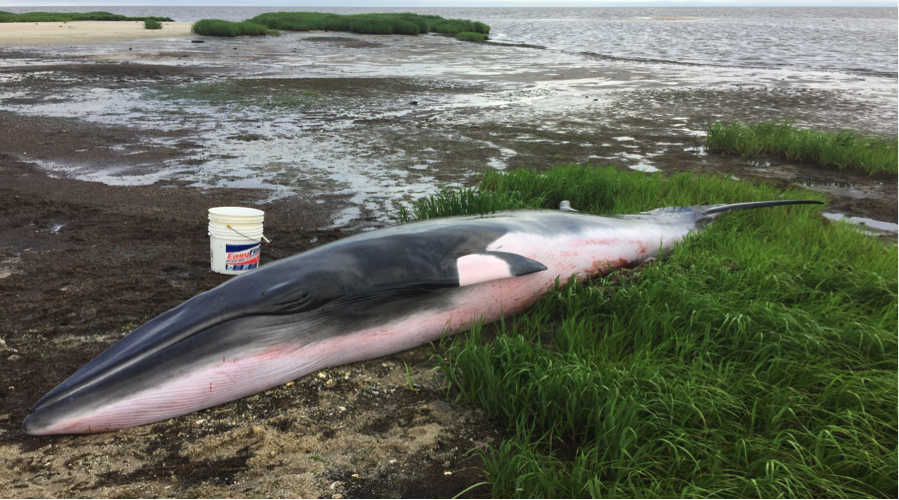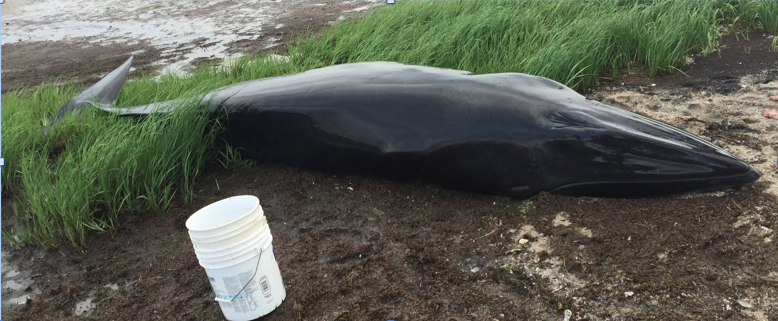Minke Whale Calf Beaches Itself Along the Delaware Bay in Cape May County, New Jersey
Last week on Sunday, June 21st, at around 6:30 PM, a one-year-old Minke calf (Balaenoptera acutorostrata) had washed up along the Delaware Bay within Cape May Court House, New Jersey, and was still alive at the time of arrival. This was reportedly the third time the calf had been beached. One-day prior, the whale was found stuck on the sandbar around Piers Point in Cape May Court House. Soon after the Middle Township Police Department’s dive team freed the whale, the young calf got stranded again 15 feet away after getting caught within the ocean’s current, where it was left to free itself since the tide was rising. After beaching itself a third time about 20 feet from the water, It was concluded by authorities such as NJ Wildlife & Fisheries Service and the Marine Mammal Stranding Center that the whale would not survive in the wild and was therefore euthanized.

One-year-old Minke calf found washed up on the Delaware Bay on Monday, on June 22, 2015, in Cape May Court House, New Jersey. Photo Credit: Shawn Karge, an on duty officer.
Minkes are classified as baleen whales, due to the presence of baleen used for filter feeding, instead of teeth. They are easily distinguished by their size, being the smallest of the baleen whales, along with a white band found along their pectoral fins, as seen above. This Minke calf had washed ashore due to a medical condition. However, most cases of beached whales are a result of human activity. Whales have few natural predators due to their enormous size, but are still identified as endangered species. Being injured by vessel strikes, fishing nets, and even oil spills, as well as ingesting marine debris, are all examples of how human activity can cause whale deaths. While it is illegal to hunt or kill marine mammals within the United States coastal region, whales are mainly subject to boating accidents, due to their inability to sense a boat at the ocean’s surface.

One-year-old Minke calf found washed up on the Delaware Bay on Monday, on June 22, 2015, in Cape May Court House, New Jersey. Photo Credit: Shawn Karge, an on duty officer. Photo Credit: Shawn Karge, an on duty officer.
Part of our research here at the Cape May Whale Watch & Research Center is identifying baleen whales that return to our area each year, individually, by the distinct pattern that each whale has on the underside of their fluke, or tail, fin. Our partnership with Whale and Dolphin Conservation, as well as other researchers allows them to use our data to keep track, by use of a catalogue, of whales that are in Cape May’s migration route, where WDC focuses specifically on Humpbacks (Megaptera novaeangliae). Since whales tend to follow the same migration route each year, this information could help further efforts to limit boat and fishing traffic within these areas to help prevent the injuries and deaths of whales that are so vital to our ocean’s ecosystem.
By Christian Karvounis, Intern at Cape May Whale Watch and Research Center, Rowan University
Sources
http://www.whale-world.com/whale-predators/
http://us.whales.org/wdc-in-action/humpback-whales-in-gulf-of-maine-usa
